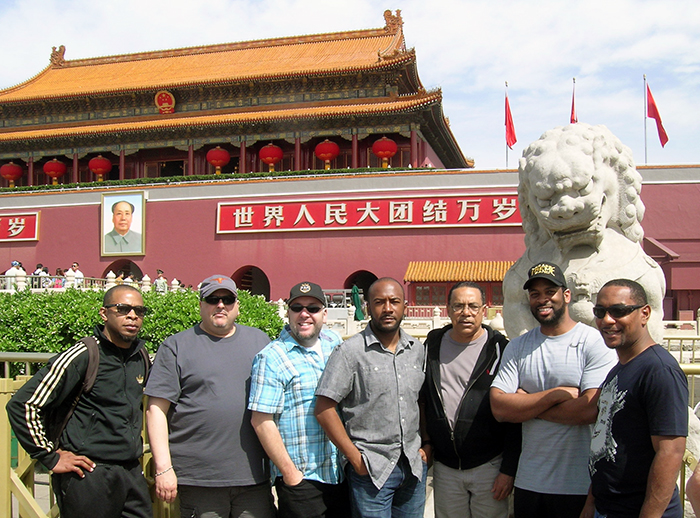In June and July 2014, more than a hundred musicians, dancers, cooks, artists, and other culture bearers traveled from China to the National Mall of the United States in Washington, D.C., to participate in the 2014 Smithsonian Folklife Festival program China: Tradition and the Art of Living. Less than a year later, the Smithsonian Center for Folklife and Cultural Heritage—in collaboration with American Routes, a New Orleans-based public radio program—brought three American “roots” music groups to Beijing for a series of concerts and performances that underscored the significance of cultural exchange and cultural diplomacy between the two most powerful economies in the world today.
The three musical groups were Los Texmaniacs, a band from San Antonio that plays conjunto music from the American Southwest and whose 2010 Smithsonian Folkways recording Borders y Bailes won a Grammy as “Best Tejano Album”; Wylie & the Wild West, a band from rural Montana that plays cowboy music, Western swing, and honky-tonk; and the Tremé Brass Band from New Orleans, which plays dirges, hymns, marches, and popular songs, often in uniform, for street parades and other special occasions in the community. Recipients of a National Heritage Fellowship in 2006 from the National Endowment for the Arts, the Tremé band was also featured recently on a Smithsonian Folkways album devoted to New Orleans brass bands.
The groups were originally scheduled to perform outdoors at the Chaoyang Pop Music Festival in Beijing, May 1 to 3, 2015. However, at almost the last minute, we had to find new venues when Chinese government authorities suddenly banned all outdoor concerts in Beijing and Shanghai, effective immediately. We were told that the ban was in response to a tragic stampede in Shanghai that killed thirty-six people on December 31, 2014. However, one source told the Associated Press that the root causes might be traced to the ruling Communist Party’s insecurities and anxieties and its need to exercise greater authority: “Whether it’s music or other activities, in China, everything is political.”
Our Chinese hosts responded with equanimity to the sudden change in plans, undoubtedly more accustomed to these sorts of government edicts than we were. In a matter of days, the China Arts and Entertainment Group—which had been our primary partner for the 2014 Folklife Festival program on China—was able to locate new indoor venues at the Rosebud Theater within the fashionable 798 Arts District and at the Beijing Foreign Studies University. However, this meant that instead of crowds numbering in the thousands for an outdoor festival, our audiences would be only in the hundreds, due to the smaller size of the indoor spaces and the inability to spread the word quickly enough about our alternate locations.

Nevertheless, those who were able to attend the performances—largely urban youth in their twenties—seemed to enjoy greatly the opportunity to hear, see, and meet traditional musical groups from the United States. For instance, Kuang Chaoye, who works as a program coordinator for the Lotus Educational Foundation, told me that she seeks American music whenever she can.
“The United States is the world’s superpower, so its music is something we listen to,” she said. “Music helps one learn another’s language and culture and to know more about its society. It is also connected to our desire to learn English.”
Similarly, Cao Jiawang, a student at Xinghai Conservatory of Music in Guangzhou, who had the opportunity to play erhu (a two-stringed traditional instrument) onstage with all of the American groups, exclaimed, “The audience loves these American bands! My instrument is part of Chinese culture, and when audiences see me with these guys, it gives them a whole new feeling. They feel proud. Many people think the erhu can play only sad, traditional music. But when I play rock ’n’ roll and jazz, they see it in a new way. I love this. It’s exciting. It makes me happy. China is more open now. We need something new for our traditions.”

The Chinese response to American roots music reaffirms one of the Center’s priority initiatives, promoting the social power of music. We know that music not only communicates social and cultural values, but may also build bonds and bridges by promoting mutual understanding and empathy across cultural differences. Bringing American musical groups to Beijing is an important first step, but bridges are best built from both sides in order to meet in the middle.
“To promote true understanding and to make understanding deeper takes more time,” Kuang Chaoye reflected. “It works both ways. Americans need to learn Chinese music and culture better.”
And as much as Cao Jiawang enjoyed playing the erhu to accompany cowboy, conjunto, and New Orleans jazz, she also observed, “It would be great if the guys could play Chinese music with me.”
Support for the musical tour was provided primarily by the U.S. State Department and the U.S. Embassy in Beijing, along with the National Endowment for the Arts, National Endowment for the Humanities, Tulane University in New Orleans, and the China Arts and Entertainment Group in Beijing.
James Deutsch made his first trip to China in 2006 as co-curator for the 2007 Smithsonian Folklife Festival program Mekong River: Connecting Cultures. He made many more trips while co-curating the 2014 Folklife Festival program China: Tradition and the Art of Living.


